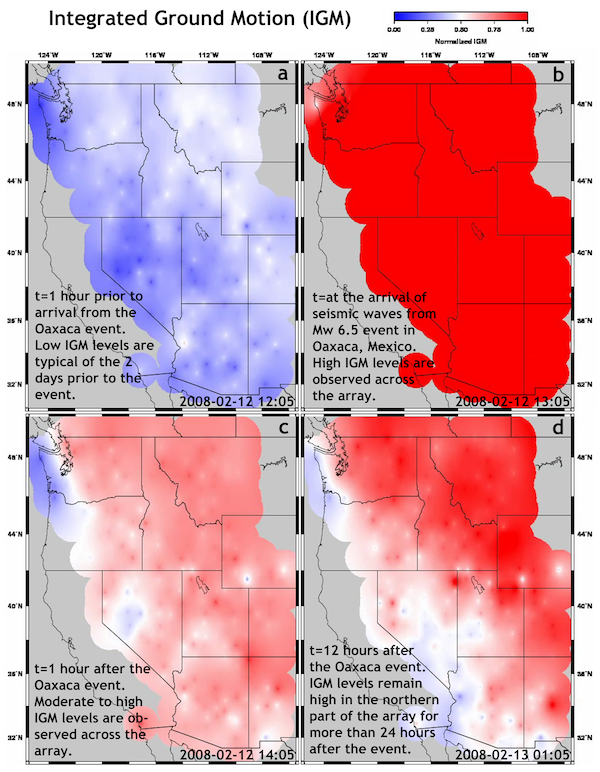2012 IRIS Workshop
Investigating Long-term Seismic Activity Using Integrated Ground Motion
John D. West: Arizona State University School of Earth and Space Exploration, Matthew J. Fouch: Carnegie Institution of Washington Department of Terrestrial Magnetism
Integrated Ground Motion, a measurement of overall seismic activity, for the TA around the time of the 2/12/2008 Oaxaca Mw 6.5 earthquake. (a-d) 1 hr before P arrival, event arrival,1 hr after event arrival, and 12 hrs after event arrival, respectively. Post-event IGM levels remain high, especially in the northern portion of the array, for >24 hrs after arrival. Causes of post-event high IGM levels could include increased seismic activity, but weather and other effects are also possible sources.

Full-resolution graphics file in original format: 0035.jpg
Integrated Ground Motion (IGM) is a time series derived by integrating the envelope of a filtered sliding window of seismic data (Magee, 2010, M.S. thesis). The resulting time series is an indicator of total ground activity within the time window, and is expected to be useful in detecting low-magnitude earthquakes, earthquake clusters, medium and long-term patterns in seismic background levels, and correlations between seismic activity and other physical phenomena such as weather patterns. In this first application of IGM, we compute envelopes over 15-minute time windows incremented every 10 minutes. Here we show time slices from preliminary results calculated for a 5-day period around the 2/12/2008 Oaxaca Mw 6.5 earthquake; high IGM levels persist for more than 24 hours after event arrival. A movie of the complete 5-day series can be viewed at http://www.anisotropy.net/IGM4.mov. Many features observable in the movie are worthy of further investigation: events smaller than the Oaxaca event, such as the Mw 5.1 Calexico event at 2008-02-11T18:30 are observable as passing signals but are not followed by longer-term increases in widespread IGM. Unusual patterns in seismicity such as the one seen at 2008-02-11T18:15 preceding the Calexico event are of unknown origin and meaning. Small local events such as the ML 3.27 event near the NV-CA border at 2008-02-11T01:47 are visible in frame 2008-02-11T01:55. Persistent regions of higher IGM levels such as seen in the Pacific Northwest from 2008-02-11T00:25 to 2008-02-11T20:35 and a similar region in northern Colorado from 2008-02-14T06:25 through the end of the movie in particular bear further investigation. The Pacific Northwest observations do not appear to correlate with recorded deep tremor detection. The methods and algorithms for calculating IGM and for creating the figures and movies shown here are still being refined; all results should be considered preliminary.
Acknoweldgements: Financial support for this work came from National Science Foundation grant EAR-0548288 (MJF EarthScope CAREER grant) and the Carnegie Institution of Washington’s Department of Terrestrial Magnetism. Productive discussions with Ed Garnero, Angela Magee, Amanda Clarke, and Ramon Arrowsmith are also acknowledged.
Keywords: seismic_background, envelope, long-term_seismicity
